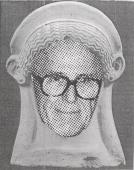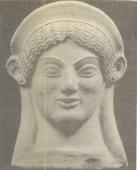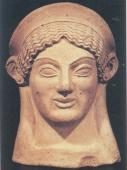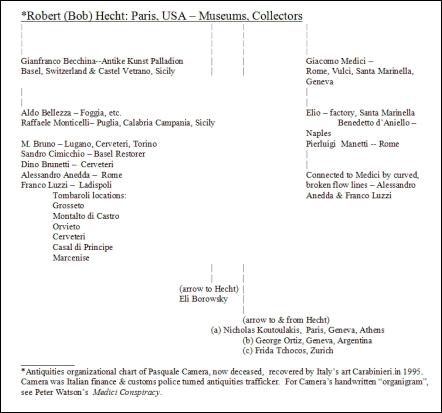Add NYT To Bob Hecht Antiquities Ring Organigram?
Add New York TimesTo Bob Hecht Antiquities Ring "Organigram"?
By Suzan Mazur



Click images for big versions
Archaic Antiquities Heads -- where are they now?
Left to right: A wavy-haired Bob Hecht; Hecht's Atlantis Antiquities "handsomely coifed" Etruscan, 500 BC, featured in 1988 New York Times; same terracotta head -- now a "Goddess" with a 1990 Sotheby's provenance -- in Jerry Eisenberg's 1995 Royal-Athena Galleries catalogue.
"Mr. Hecht is well known in the world of ancient art, especially for the Archaic Period, whence came the much publicized Attic Greek vase by Euphronios that he sold the Metropolitan Museum of Art for $1 million in 1972. When the acquisition was announced, the Italian Government protested, charging that the vase had been excavated recently and exported illegally, claims that were denied by the museum and later dropped by the Italians." --Rita Reif, New York Times, 6/18/88

Click for big version
CHART: *Robert Hecht: Paris, USA--Museums, Collectors
While various American antiquities dealers, curators and collectors are "subjects of interest" of Italian and Greek prosecutors who, in the last year, particularly, have opened the floodgates for the return of their countries' cultural patrimony - the question is: Why not the media?
For instance, there is no finer example of promotion and protection afforded the antiquities trade than New York Times reporter Rita Reif's June 1988 plug for art dealer Bob Hecht in the story titled, "Archaic Smiles Have Persisted for 2,000 Years". Hecht is on trial in Rome for trafficking in ancient art --charged with being one of the capos, if not the mastermind of an international conspiracy.
But the media's entanglement starts much higher up than Reif. It begins with the NYT Sulzberger publishing family and includes its stable of art critics who have for decades serviced Hecht and other dealers selling antiquities without provenience (site from which artifact is plundered or excavated) with their unquestioning reviews of exhibitions and objects.
Arthur Sulzberger, Sr. (Punch), while publisher of the paper and as a member of the Metropolitan Museum of Art's Acquisition Committee, even voted to purchase Italy's priceless Sarpedon Euphronios vase from Hecht -- which, after 34 years, finally bears the legend "the Republic of Italy" and awaits its 2008 ticket home. Punchy Sulzberger has been a member of the Met's Acquisitions Committee for more than 34 years and chaired the committee for a time.
No one has been more vocal in pointing out the connection between the Times and the antiquities trade than Met Ancient Near East expert, Oscar White Muscarella, one of the heroes of the 1974 book by John L. Hess, Grand Acquisitors , as well as Peter Watson's recent Medici Conspiracy (Muscarella's "scholarship, his attention to detail, his sheer resoluteness, has a certain magnificence").
Muscarella now says this regarding the collusion of the NYT with the traffickers of plundered ancient art:
"Rita Reif is only one of the New York Timespimps covering up her bosses' plundering. Reif innocently betrayed her consciously corrupt behavior when she went berserk a few years ago after discovering that art stolen from her family in Austria decades ago had recently surfaced. She was furious that anyone would steal from her family. She demanded justice, demanded with a fervor that art stolen from her family -- now belonging to her -- be returned immediately! Indeed, Reif's behavior over the years manifests loud and clear that defending and covering up her employers' corrupt actions -- the plundering and destruction of sites and cultures all over the world -- is fine, correct, honorable behavior by a United States citizen. Just don't mess with her property.It was New York Timesreporters John Canaday and Grace Glueck, however, who first set the pace for this behavior: Never, ever, ever mention the word PLUNDER when writing -- always a glorious, excited review about either the Met's own plundered ancient art or such looted material on loan from a very rich collector or another plundering museum. The proof of collusion is all there in the Times reviews written through the years, particularly by Rita Reif and Holland Cotter; also Michael Kimmelman ( NY Times, December 12, 2005, Arts , pp. 1, 4). Not one has written a word about the real origin of the objects they gush over, how the museum and collectors acquired them, or even hinted that the objects are stolen. Nothing of the dark journey of the loot to the United States. That the Met's Director and Trustees, including Chairman Arthur A. Houghton and Punchy Sulzberger, purchased such objects from dealers in plundered art is the terrible truth not fit for printing in the New York Times."
Now with Bob Hecht in the hot seat, the Reif NYT "Smiles" article stands out as particularly egregious, almost as an unpaid ad for Hecht's 1988 Atlantis Antiquities gallery show in Manhattan: "Greek and Etruscan Art of the Archaic Period". Reif even went so far as to give prices of the artifacts then for sale. Many, if not most, of the pieces were without provenience, winding up later on the block at Sotheby's and in Hecht's own auction.
First, here's some of the Reif fluff:
"Contented smiles transform the features of both young muscle-flexing athletes and mature, handsomely coifed women. . . . There are glorious bronze griffins, eagles, lions and a horse, all of them believably fierce or regal but softened by naturalism. A bronze griffin from Samos is a friendly beast with a hooked beak, curled tongue, pointed ears and no fangs. A surprisingly stolid bronze bull seems as tame as a lamb. . . . Several painted vases by named and anonymous artists in this exhibition surpass the bronzes in craft skills. . ."
Reif said the Hecht exhibit included 70 pieces in terracotta, marble, bronze, gold, amber and clay. The "handsomely coifed" terracotta head of a woman, 500 BC, that Reif refers to in the article was accompanied by a 4" x 5" photo. The piece later turned up as a sold item in New York dealer Jerry Eisenberg's January 1995 catalogue, Art of the Ancient World, listed as an:
"Etruscan Terracotta Votive Head of a Goddess, wearing veiled stephane over wavy hair falling to neck. Veii, Etruria, early 5th Century B.C. H. 11 1/8" (28.3 cm.) Cp. heads from Porto Naccio Temple, Veii, in Spreinger-Bartolini, Die Etrusker, 87, 188/189."
Eisenberg picked it up in a Sotheby's sale in 1990 (consigned by Hecht?) for $16,500, and resold it in 1994 to an anonymous Asian collector for $40,000. Where the Etruscan Goddess is now is anyone's guess.
Reif continued to pump up Hecht in her "Achaic Smiles" story, adding to his public swagger with this: "Archaic Period artifacts like the ones on view at Atlantis are stocked by other dealers, but not in the scope and quantity represented in this show."
Again,
no Reif comment about how Hecht acquired his impressive
collection.
Instead, Reif lets Hecht spin on: "This is
material accumulated over many, many years . . . My
affection is with the sixth and early fifth century B.C."
Reif then comes in for the hard sell -- announcing prices, ranging from "$500 for a fragment to $300,000 for a stone sculpture, with most between $5,000 and $40,000" and gives the show's end date of July 9.
She leaves unsaid: "Three weeks left. Hurry while supplies last!"
As mentioned, Hecht then organized his own auction -- at New York's Park Lane Hotel. I attended the November 27,1990 auction where some of the Atlantis exhibition pieces Reif describes were again for sale, and with Hecht visibly buying back a few. Most of the lots went for prices below or near estimate.
Hecht and his Summa Gallery partner on Rodeo Drive, Bruce McNall, were splitting up and liquidating their inventory. McNall owned Summa, but Hecht had holdings -- the stock for Summa was originally supplied by Hecht. McNall writes in his book Fun While It Lasted, "In fact, I hardly ever acquired pieces from anyone else."
McNall did not show up at the Park Lane auction. And later in the 1990s he went to prison for "bilking banks" out of $200 million.
The Park Lane auction followed the Hunt-Sotheby's auction of June 1990 in which most of the Hunt pieces bought from McNall and on the block also originated with Hecht and Hecht's supplier, Giacomo Medici.
Medici was on hand at the Sotheby's sale to buy back the signed Euphronios wine cup he'd first marketed through Hecht to Bunker Hunt. Dealer Robin Symes, now out of jail in the UK but facing Italian prosecutorial scrutiny, bought the other (fragmented) Euphronios vase at Sotheby's, selling it to Shelby White's husband, Leon Levy (since deceased). Medici's appeal regarding his 10-year sentence for antiquities trafficking will be heard in Rome in October.
The November 27 Hecht-McNall sale was organized under the banner of Hesperia Arts Auction, Ltd. And there were two catalogues presenting the pieces, co-authored by Hecht and Jasper Gaunt -- the current Greek and Roman curator at Emory University's Michael C. Carlos Museum in Atlanta.
The antiquities buy-back scheme is something Peter Watson refers to in the Medici Conspiracy - although Watson never mentions the Hesperia auction. Watson reports that Italian investigators concluded the practice was all about laundering looted artifacts, giving pieces a chance to acquire some kind of provenance (history since plundering or excavation) before repurchasing them.
Hesperia Arts was a company Hecht first put together after World War II with Vladimir Steffanelli, a Roumanian coin expert Hecht found working in Europe after Steffanelli's release from Buckenwald. Hesperia's headquarters were on 57th Street in New York but the company gradually ceased to function on a day-to-day basis following Hecht's move to Italy in the late 40s/early 50s -- according to Steffanelli's wife Elvira, a former Smithsonian coin curator.
Apparently, Hesperia had at least one more useful life.
The major players were all there at the November 27 Hesperia sale - Hecht, his Atlantis Antiquities financier - collector Jonathan Rosen, Robin Symes, Ed and Sam Merrin, Fuat Uzulmez, Torkom Demirjian, Jerry Eisenberg, Fred Schultz, Robert Haber as well as the Metropolitan Museum's Greek and Roman Curator - Dietrich von Bothmer.
Among the pieces mentioned by Reif that Hecht visibly bought were a 5th c. BC Sardinian bronze bull for $12,500 [est. $20,000-$25,000] and a 7th c. BC East Greek Bronze Griffin, mouth open but no fangs, ears pricked for $4,500 [est. $3,000-$4,000].
A major Hecht purchase -- $425,000 -- was an Attic Red Figure krater with the theme of Amazonomachy (warrior women), Pan Painter, 470-460 BC [est. upon request].
Jerry Eisenberg spent $1 million buying two dozen pieces. He said during my visit to his well-stocked gallery, which sells largely but not exclusively "minor" pieces of ancient art (some clumsy in execution), that he considers himself an "honest dealer". When I asked who else he considers an honest dealer, he said he had "no comment" about others in the New York trade, and gave the names of a few Swiss & British dealers he respected.
He thought author Peter Watson was making too much of the provenience issue in his book, however, and said pieces in the 70s, 80s and 90s generally lacked provenience not just those handled by so-called questionable dealers.
The current auction house requirement of full disclosure for even minor pieces of ancient art, said Eisenberg, is "extreme" (names of consignees and their sources are being offered up), and he claimed it is only "driving up the price of important antiquities, making them even more desirable".
Some of Eisenberg's purchases at Hecht's Hesperia auction included:
- two Apulian Red Figure kraters 350-350 BC by the Baltimore Painter for $82,500 [est. $80,000-$90,000] - the vases were $90,000 for the pair at McNall's gallery prior to the auction. Eisenberg said he sold them to a dealer (un-named) in San Diego for $85,000 each.
- Roman marble of a scene from the Iliad with the warrior Menelaos supporting a dying Patroklos in his arms, 2nd c. AD, for $150,000 [est. $250,000-$275,000]. He resold the piece "down South" in December 1995 for $300,000
- 1st c. AD, Roman marble of Zeus as an eagle clutching Ganymede with talons (considered ancient pedophile art) for $40,000 [est. $35,000-$40,000]. Eisenberg exchanged the piece with another dealer but did not say who.
Curiously, however, this ancient pedophile art turns up in Eisenberg's sales catalogue of January 2000/Volume XI, Art of the Ancient World, "Millennium Edition", as object #28 -- Roman Marble Relief of Zeus and Ganymede -- with Eisenberg noting that the piece previously appeared in his sales catalogue of 1991/Volume VI. Eisenberg lists no provenance between the 1991 and 2000 dates, and describes the object as follows:
"Zeus, disguised as an eagle, clasps Ganymede, son of Tros, King of Troy, tightly against his breast as they look at each other intently. [Hecht wrote "affectionately" and "Regarding the homosexual idea Theognis (a poet of the sixth century B.C.) already mentions Zeus' precedent for the prevailing pedophilia of his times."]
The scheme of the composition is so similar to that of the relief of decorations of a bronze mirror formerly in the Staatliche Museen of Berlin (LIMC195; Zuchner, Klappspiegel 623, pl. 7) that the two were possibly derived from the same prototype. Early Imperial, 1st century A.D. H. 14 5/8" (37.1 cm.) Homer (Iliad 5, 265) also informs us that Zeus compensated Troy with a gift of excellent horses. . . ."
Robin Symes purchased a bronze strip once covering a Roman altar with applique figures of a bearded man (possibly a priest) holding a bird and followed by a bull, 212-209 BC. He paid $30,000 [est. $40,000-$50,000]. The piece had two inscriptions :
"For the well being (or safety) of the Emperors Caesar Augustus Severus Antoninus (Caracalla) (and) Caesar Augustus Geta (and) Julia Domna Augusta." and"To Jupiter Optimus Maximus of Anthemusia (a city in Mesopotamia) Lucius Dasculus Priscus Maximus had this made with his own means."
Symes also bought an East Greek gold applique of a cow suckling a calf, 550-525 BC for $50,000 [est $30,000-$35,000], and a "miniature masterpiece" in lapis lazuli of the head of Pharaoh Ramesside XIX Dynasty for $40,000 [est. $50,000-$75,000] -- Provenance: Ex-Hubert Weiser Collection.
Torkom Demirjian took an Etruscan Bronze Warrior, 460 BC, for $260,000 [est. $240,000-$280,000].
Fred Schultz paid $100,000 for a Roman mosaic of a comic mask, 1st c. AD [est. $75,000-$85,000] . Schultz went to jail in 2002 for conspiring to traffic in stolen property, i.e., Egyptian antiquities.
Hecht's Atlantis Antiquities financier, collector Jonathan Rosen, fancied the carved seals and amulets. One, a Mesopotamian lapis lazuli amulet 2,800 BC-2,370 BC, bore the inscription: "Rimush, King of Kish" [est. $25,000 - $35,000]. Rosen paid $30,000 for it.
Unfortunately, I have no notes in my catalogues about the bidding by Hecht's pal Fuat Uzulmez, who journalists Ozgen Acar and Melik Kaylan describe in Connoisseur magazine ("The Turkish Connection", Oct. 1990) as the handsome "top lieutenant" in Munich's Turkish antiquities mafia and who Hecht's daughter knew as "Uncle Fuat". But how can I forget Uzulmez putting his arm around me on the way out of the Hesperia auction and whispering in my ear, "We are going to kill him [Acar]."?
Getting back to the media's role in the trade, however, and Rita Reif's scandalous "Archaic Smiles" piece -- in it Reif also pitched Hecht's 78-page catalogue for his Greek and Etruscan show, giving the price as $20. And she noted that the introduction to the catalogue had been written by the Boston Museum of Fine Arts Greek and Roman curator, Cornelius Vermeule (Hecht's pal), whom she quoted.
This arrangement may have served as inspiration for New York dealer Ed Merrin's Cycladic catalogue, which he got Brooklyn Museum Director Robert Buck to write the intro to, selling the book for $10 or so a copy. The Merrin catalogue was part of a Cycladic Arts exhibition at New York's Merrin Gallery held in March/April 1990 as a benefit for Brooklyn Museum, but with one room showcasing pieces for sale with profits going to Merrin Gallery.
Italian prosecutors have also been scrutinizing Merrin's trade in ancient art, particularly his connection to European dealer Gianfranco Becchina (Becchina is a point man in the Hecht antiquities flowchart above.)
Never is there a whisper in the Rita Reif "coverage", however, about Bob Hecht and trafficking of ancient art . Hecht gets much more than a pass and "Smiles" from the New York Times. Hecht gets applause.
 Suzan
Mazur's stories on art and antiquities have been published
in The Economist, Financial Times, Connoisseur, Archaeology
(cover) and Newsday. Some of her other reports have appeared
on PBS, CBC and MBC. She has been a guest on McLaughlin,
Charlie Rose and various Fox Television News programs.
Email: sznmzr @
aol.com
Suzan
Mazur's stories on art and antiquities have been published
in The Economist, Financial Times, Connoisseur, Archaeology
(cover) and Newsday. Some of her other reports have appeared
on PBS, CBC and MBC. She has been a guest on McLaughlin,
Charlie Rose and various Fox Television News programs.
Email: sznmzr @
aol.com


 Eugene Doyle: The West’s War On Iran
Eugene Doyle: The West’s War On Iran Richard S. Ehrlich: Deadly Border Feud Between Thailand & Cambodia
Richard S. Ehrlich: Deadly Border Feud Between Thailand & Cambodia Gordon Campbell: On Free Speech And Anti-Semitism
Gordon Campbell: On Free Speech And Anti-Semitism Ian Powell: The Disgrace Of The Hospice Care Funding Scandal
Ian Powell: The Disgrace Of The Hospice Care Funding Scandal Binoy Kampmark: Catching Israel Out - Gaza And The Madleen “Selfie” Protest
Binoy Kampmark: Catching Israel Out - Gaza And The Madleen “Selfie” Protest Ramzy Baroud: Gaza's 'Humanitarian' Façade - A Deceptive Ploy Unravels
Ramzy Baroud: Gaza's 'Humanitarian' Façade - A Deceptive Ploy Unravels